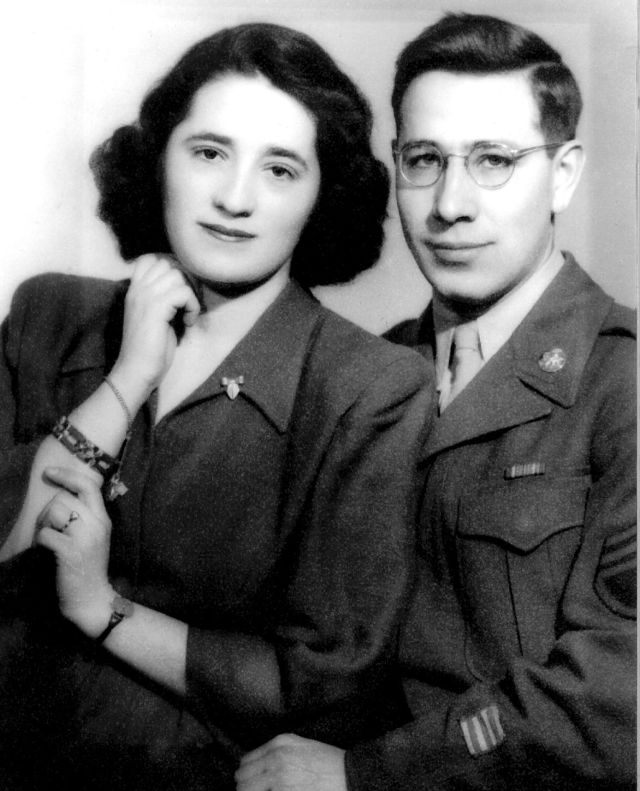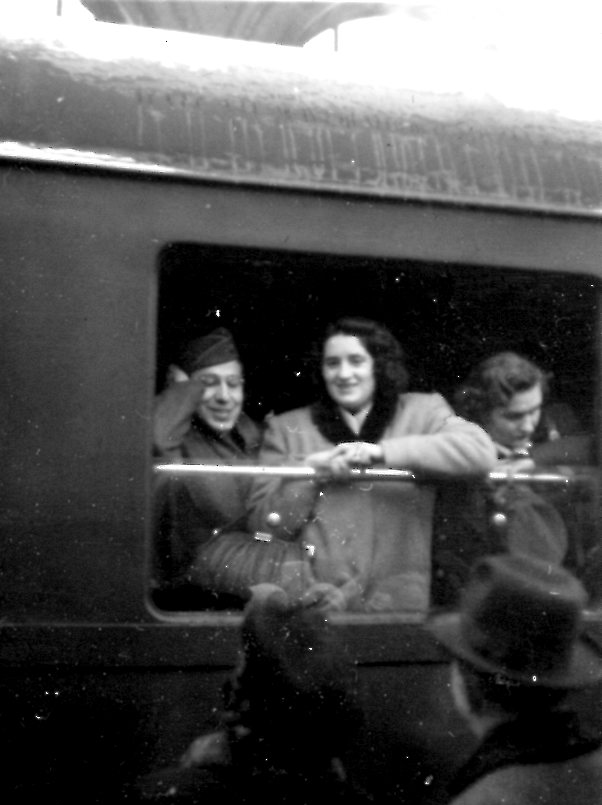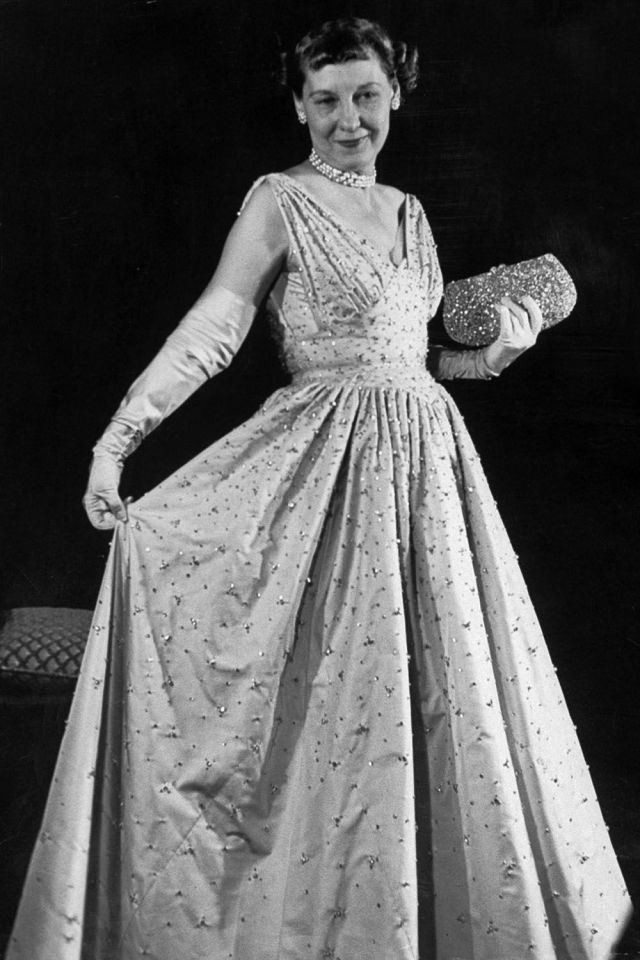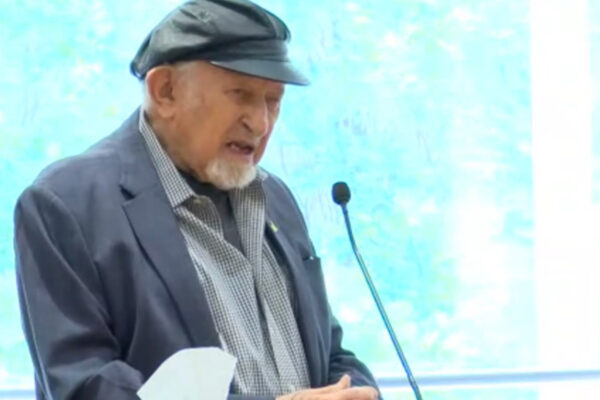At 95, Judith Leiber carefully walks down an aisle of her palladian-style Hamptons museum surrounded by 1,500 handbags, most of them bedazzled with thousands of crystals. Her eyes graze two small metal clutches—one shaped like an eggplant and the other, an asparagus. “I just thought it was a good idea to try to make something strange we’d never made before,” Leiber shrugs. “They’re still selling.”
It has been 70 years since the designer—who married an American soldier during World War II after living in a Jewish ghetto basement with 60 other Holocaust survivors—arrived in New York on a brideship provided by the U.S. military. Then just 26 years old, she carried nothing with her but a green toolbox and her ability to build a bag from start to finish. “I guess chemistry never worked out. So I became a bag lady,” Leiber deadpans.

Judith Leiber pictured with her American soldier husband, Gerson Leiber, in 1946 Courtesy of Judith Leiber
Born Judith Peto in 1921, Leiber left her hometown in Budapest, Hungary, for King’s College London in 1938, where she studied chemistry for the cosmetics industry. Betting that London would be a stronghold if WWII erupted, her banker father chose the school to effectively send his daughter to safety. However, a trip home for the summer quickly changed Leiber’s trajectory. “When the war broke out, I couldn’t go back [to London], so I stayed in Hungary with my family,” she says. Hitler bombed Poland in 1939, and though Leiber was still registered at King’s, she refused to leave her family.
To distract herself from the encroaching war, Leiber went to work. Family connections landed her at the prestigious handbag company Pessl, where she learned to cut and mold leather, make patterns, and frame and stitch bags into completion. Leiber graduated to journeyman and finally to master craftswoman. A green toolbox was part of her diploma, holding essential tools that allowed her to create bags from concept to completion.
“Judith Leiber arrived in New York at 26, with nothing but a green toolbox and her ability to build a bag from start to finish.”
During this time, many of Leiber’s relatives in other parts of Europe were forced into concentration camps. Nazi soldiers killed three of her uncles who refused to wear the Jewish yellow star, also grabbing her father and deploying him to a work camp. Leiber’s family feared he would starve, be worked to death, or shot, so they begged a friend’s uncle for a Swiss Pass from the Swiss Consulate where he worked, and her mother paid a postman to deliver him safely. A 16-year-old family friend added “and family” to the pass, allowing them to flee their home to cram into the small but safer apartment in Budapest that was under Swiss jurisdiction.
“There were 26 people in a one bedroom apartment. It was pretty terrible,” remembers Leiber. Barred from leaving the house by her parents, Leiber gave up her beloved Pessl job and slept with the 25 others on mattresses on the floor. “I designed handbags in my head to get through the misery,” she says

Judith Leiber pictured leaving Budapest for New York in December, 1946 Courtesy of Judith Leiber, Photograph by Eva Peto
The move didn’t last long. In December of 1944 those in the apartment were soon corralled into ghettos by the Hungarian Nazis (Germans created at least 1,000 ghettos—enclosed districts that separated Jewish communities from the non-Jewish population—in German-occupied territory), where Nazi soldiers planned to sweep them into death camps. Constant bombs, grenades and machine gunfire shattered most of the city of Budapest as both the Soviets and Germans battled to take Budapest, Hungary’s capital. After the Russian Liberation, which saved the ghetto from being forced in concentration camps, Leiber’s family moved into a basement with 60 others. To keep her sanity, Leiber continued to design intricate handbags with her imagination.
A softer side of life returned when the Americans arrived, she says. With the city still in ruins, Leiber began the arduous task of piecing back her life, and through a mutual friend she was connected with the secretaries of the American Legation who commissioned Leiber to create bags for them. Earning American dollars, Leiber was finally able to buy food and essentials for her family. It was during this time that Judith locked eyes with Gerson “Gus” Leiber, an American G.I. from Titusville, Pennsylvania on the bombed streets of Budapest. Their first date was to the opera—the pair enjoyed a courtship of the finest things his American dollars could buy. Married within the year, the Leibers fled to New York, arriving to find most Manhattan apartments already snagged by the vast numbers returning from the war. The newlyweds settled into a furnished room in the Bronx, and it was here that Leiber began her corporate climb.
“I designed handbags in my head to get through the misery.” – Judith Leiber
It was a relative of Gus’ who recommended her for her first job as a seamstress using an electric sewing machine. But Leiber, who only knew how to use a foot treadle, took a job at Garay & Co. instead. Despite her ability to make an entire leather bag from concept to showroom model, Leiber’s creativity was stifled with retailers looking to copy European designs, rather than create their own. Frustrated, she turned to the handbag union, where, as detailed in her biography, No Mere Bagatelles by Jeffrey Sussman, Leiber forced her way to the head of the union, Philip Lubliner with her green toolbox in hand; passing his secretary’s screening by saying she had a “private matter” to discuss. Once in his office, she simply told him: “I want to make handbags from start to finish.” Lieber was soon introduced to designer Nettie Rosenstein, known for her little black dresses and chic costume jewelry. Leiber began as assistant pattern maker in 1948, eventually overseeing the brand’s New York factory as pattern maker, designer, and foreman for the last few years of her 12 years there.
Then in 1953, everything changed. Mamie Eisenhower stepped out at the inaugural ball with a bag—intricately embroidered with pearls and rhinestones—designed by Leiber under the Nettie Rosenstein name, instantly propelling her already growing reputation among celebrities and socialites to a household name. Soon, Rosenstein gave Leiber the leeway to make anything she wanted. “While at Nettie Rosenstein, Judith became known amongst fashion editors and reporters as a premier handbag designer. When it became known that Judith had designed Eisenhower’s handbag that was carried to her husband’s presidential inauguration, Judith’s name and prestige took off. She became known as an important asset to Nettie Rosenstein,” explains the biographer Sussman.

In 1953, Mamie Eisenhower stepped out at the inaugural ball with an embroidered bag designed by Judith Leiber Getty
Originally Published Here







